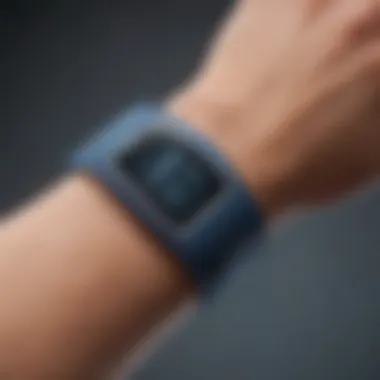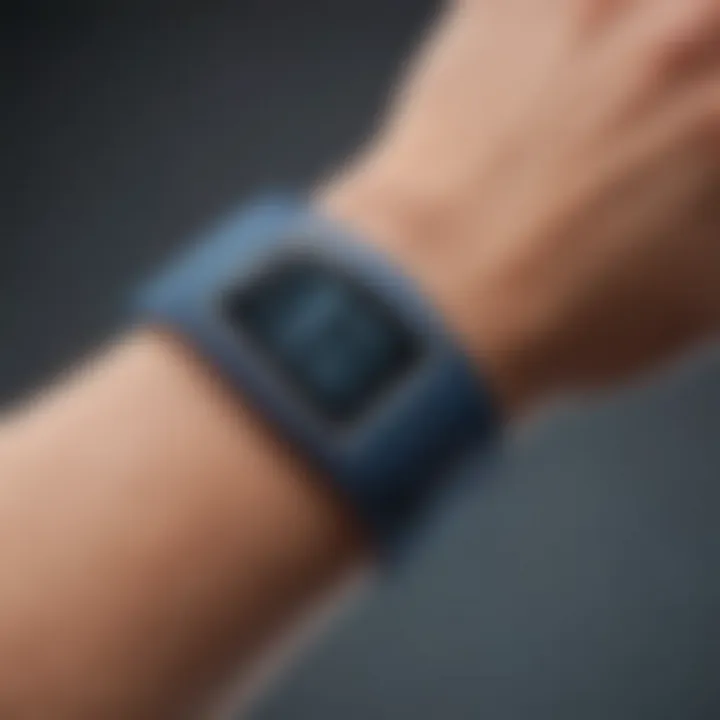Understanding Actigraph Wrist Bands: Applications & Benefits


Intro
Actigraph wrist bands have emerged as pivotal tools within the realm of health monitoring, sleep research, and physical activity tracking. Their design integrates advanced sensors and software that facilitate the collection of precise data regarding an individual’s activity levels, sleep patterns, and overall health. In this comprehensive examination, we will unravel the various dimensions of actigraph wrist bands—exploring their mechanisms, applications, benefits, and potential limitations.
Understanding how these devices work and their significance can empower researchers, educators, students, and health professionals. Thus, as we delve deeper into actigraph wrist bands, we will strive to present a clear and informative narrative that shines light on their relevance in both scientific research and everyday health management.
Research Overview
Methodological Approaches
Actigraph wrist bands utilize a combination of accelerometry, heart rate monitoring, and gyroscopic sensors to quantify motion in three-dimensional space. The data collected is analyzed through sophisticated algorithms that convert raw measurements into user-friendly metrics. This enables a multitude of applications ranging from assessing moderate to vigorous physical activity to determining sleep quality and duration. Researchers often employ these devices in longitudinal studies to gather comprehensive data over extended periods, enhancing the reliability and depth of findings.
Significance and Implications
The implications of utilizing actigraph wrist bands in research are substantial. Their ability to collect objective data adds credibility to studies concerning physical activity, sleep disorders, and other health-related variables. Accurate tracking can influence intervention strategies in public health recommendations and personal health management. With growing awareness of lifestyle diseases, these devices offer insightful data for tailoring individual health strategies.
Actigraph wrist bands are not just tools for researchers; they provide everyday users with data that can lead to informed lifestyle choices.
Current Trends in Science
Innovative Techniques and Tools
Recent developments in wearable technology have extended the capabilities of actigraph wrist bands. Modern versions often incorporate additional features such as Bluetooth connectivity, allowing for real-time data monitoring and seamless synchronization with mobile applications. Such advancements lead to more personalized data analysis and, consequently, enriched user experience.
Interdisciplinary Connections
The application of actigraph technology is not confined to health alone. Fields such as behavioral science, sports training, and even psychology benefit from the insights provided by these devices. The interdisciplinary nature of actigraph research fosters collaboration among experts, leading to innovative approaches in understanding human behavior and physiology.
Intro to Actigraph Wrist Bands
Actigraph wrist bands play a significant role in health monitoring and research, making them crucial for understanding various physiological behaviors. They offer a non-invasive means to collect data regarding physical activity and sleep patterns. These devices help healthcare professionals, researchers, and individuals monitor health metrics easily. The potential benefits of understanding Actigraph wrist bands extend to improved health management, effectiveness in chronic disease tracking, and enhancing research in sleep studies.
Definition and Overview
Actigraph wrist bands are sophisticated devices designed to track and analyze physical activity and sleep. They utilize an array of sensors to measure movement and rest patterns, providing valuable data on an individual’s lifestyle. The bands are equipped with accelerometers that capture movement in three dimensions, compiling the data into understandable metrics. This enables users to assess their daily activity levels, which can be instrumental in reaching fitness goals or managing health conditions. Moreover, some models connect to applications that offer additional insights and analytics based on the collected data.
Historical Context
The development of Actigraph wrist bands is rooted in the evolution of wearable technology. Early pedometers and heart rate monitors laid the groundwork for more complex devices. Over time, advancements in sensor technology and data processing made it possible to create devices that not only count steps but also analyze patterns in movement and rest. Actigraph itself has played a critical role in this transition since its inception in the late 1990s. Initially popular in clinical research, their applications have expanded significantly, now encompassing personal health management and public health initiatives. As technology progressed, the increase in accessible data brought about new research opportunities and public awareness of health metrics.
Technical Specifications
Understanding the technical specifications of Actigraph wrist bands is crucial for comprehending their impact and functionality. Key aspects like sensors, data collection methods, and battery life define how effectively these devices operate and serve their users.
Sensors and Mechanisms
Actigraph wrist bands utilize a variety of sensors to gather data about user activity and other physiological metrics. The most common sensors include accelerometers, gyroscopes, and heart rate monitors. Accelerometers measure the acceleration force on the wrist, providing insights into physical activity levels, while gyroscopes detect changes in orientation. These two types of sensors work in tandem to offer a comprehensive overview of movement patterns.


The mechanisms behind these sensors involve sophisticated algorithms that interpret raw data into meaningful metrics. The data is processed to provide insights into the intensity of activities, duration, and overall patterns of movement. This capability is particularly beneficial for researchers and health professionals looking to track physical activity over time.
Data Collection and Storage
Data collection is a significant part of how Actigraph wrist bands function. They collect vast amounts of data continuously, often over extended periods, to monitor user activity accurately. This data is usually stored internally in the device until it is synced with an external platform for analysis.
Storage capacity varies by model but generally allows for extensive data retention. Some devices can hold data for weeks or even months prior to transfer. Once the data is transferred to a computer or mobile application, users can analyze their activity levels, sleep patterns, or other metrics displayed through graphs and summaries.
Effective data storage and retrieval ensure that the recorded analyses are precise and useful, which is a cornerstone for accurate health assessment.
Battery Life and Durability
Battery life and durability are critical considerations for anyone using Actigraph wrist bands. Users expect devices to last through daily wear without frequent recharging. Most modern wrist bands are designed with energy-efficient components, often allowing for a battery life that ranges from five days to several weeks, depending on usage patterns and settings.
Durability is equally important. Actigraph bands are built to withstand daily activities, which might include sweating or occasional bumps and drops. Many models are water-resistant or even waterproof, enhancing their usability in various environments. This resilience ensures that users can rely on their devices for consistent data collection without worrying about damage from normal wear and tear.
Applications in Health Monitoring
The applications of actigraph wrist bands in health monitoring are extensive and significant. These devices serve as practical tools for tracking various aspects of individual health, particularly in relation to physical activity, sleep quality, and chronic disease management. The primary benefit of these applications is their ability to gather accurate, real-time data, which can inform both personal health decisions and broader medical research.
Physical Activity Tracking
Actigraph wrist bands excel in monitoring physical activity levels. They use sensors to detect movement patterns, enabling the assessment of both intensity and duration of activities. This data helps users understand their daily exertions better. For example, someone might realize they are not as active as they presumed based on their routine. Such insight can effectively motivate individuals to increase their activity.
Furthermore, comprehensive tracking can assist healthcare providers in creating personalized fitness plans. By analyzing the data collected, practitioners can identify trends in a patient’s activity levels, advising accordingly. This approach supports preventative healthcare strategies as well, as maintaining an active lifestyle can reduce the risk of chronic disease.
Sleep Quality Assessment
Measuring sleep quality is another crucial application of actigraph wrist bands. They monitor various sleep metrics, including sleep duration, efficiency, and disturbances during the night. This data can offer insights into sleep patterns that might not be apparent to the wearer.
Many individuals struggle with sleep-related issues. With the help of actigraph data, users can recognize factors affecting their sleep and make informed adjustments to their routines. The implication here extends to mental health as well. Poor sleep quality is often linked to anxiety and depression, so understanding and addressing sleep problems can yield comprehensive health benefits.
Chronic Disease Management
In the realm of chronic disease management, actigraph wrist bands present a valuable asset. They allow for ongoing monitoring of patients with conditions such as diabetes, obesity, and cardiovascular diseases. Continuous data collection helps track engagement in prescribed exercise regimes or adherence to health protocols.
For patients with chronic conditions, frequent feedback can significantly impact compliance. When users can see data on their activity levels and health metrics, it creates a sense of accountability. This method has proven beneficial in helping to manage symptoms and improve overall quality of life.
"Actigraph wrist bands not only encourage a more active lifestyle but also empower users to actively participate in their own health management."
In summary, the applications of actigraph wrist bands in health monitoring are crucial. They provide insightful data that can vastly improve individual well-being and assist healthcare professionals in delivering tailored care. Their importance cannot be overstated in today's world, where health management is becoming increasingly data-driven.
Research Applications
Research applications of Actigraph wrist bands represent a significant aspect of their value in today’s scientific landscape. These devices have become essential tools in various fields including clinical health research, behavioral studies, and public health initiatives. The ability to objectively collect data on physical activity levels and sleep patterns in real-time makes them indispensable for researchers aiming to understand human behavior and health.
Clinical Trials and Studies
In clinical trials, Actigraph wrist bands offer precise and reliable data. Researchers can monitor participants’ physical activities and sleep quality without the need for intrusive measures, thus enhancing compliance. These wrist bands gather valuable information on activity intensity, frequency, and duration, which are critical for evaluating the effectiveness of medical interventions. The data gathered can significantly influence study outcomes and help in identifying any correlations between behavior and health indicators.


Clinical trials benefit from Actigraph technology as it reduces biases associated with self-reported data, offering a more accurate picture of participants’ health behaviors.
Behavioral Research
In behavioral research, Actigraph wrist bands provide insights into how physical activity and sleep correlate with various psychological and social factors. By collecting continuous, objective data, researchers can track changes over time. This data is crucial in understanding lifestyle patterns and their impact on mental and emotional well-being. For instance, studies may reveal connections between lack of physical activity and increased feelings of anxiety or depression. The convenience of these devices allows for large sample sizes and diverse populations to be studied, enhancing the validity and reliability of results.
Public Health Initiatives
For public health initiatives, the importance of Actigraph wrist bands cannot be overstated. They help in designing effective interventions by providing data that reflect community health behaviors. Health organizations can track trends and patterns in physical inactivity and poor sleep, making it easier to tailor programs aimed at promoting healthier lifestyles. The widespread adoption of these devices can enable public health officials to assess the efficacy of community programs and initiatives aimed at combating lifestyle-related diseases.
In summary, the application of Actigraph wrist bands in research contributes significantly to various disciplines. They enhance data accuracy, encourage participant compliance, and facilitate better understanding of health behaviors, which ultimately aids in improving individual and public health strategies.
User Experience and Usability
Understanding user experience and usability is essential when discussing Actigraph wrist bands. These devices play a critical role in health monitoring, and their effectiveness often hinges on how easy they are to use, interpret, and integrate into daily life. A positive user experience can increase adherence to health recommendations and ensure that the data captured is reliable and useful.
Comfort and Design
The design of Actigraph wrist bands significantly affects user comfort. A well-designed wrist band should fit securely yet comfortably on the wrist without causing irritation during daily activities or sleep. Lightweight materials and adjustable straps are favored features. For example, having a sleek form factor can encourage users to wear the device consistently, which in turn enhances the data accuracy.
In addition to physical comfort, aesthetic appeal is an important aspect. Users are more likely to wear a device that looks good and matches their personal style. Actigraph brands often offer multiple color options and customizable features to cater to diverse preferences.
Interpreting Data Outputs
Effective interpretation of data outputs is crucial for users of Actigraph wrist bands. The raw data collected can be overwhelming without a clear system for analysis. Many devices come with user-friendly applications that simplify the graphing and trending of physical activity and sleep quality. These applications often include visual aids like graphs and summary reports, making it easier for users to understand their behavior patterns.
Additionally, guidance on how to interpret these outputs can empower users to make informed decisions regarding their health. Educating users on key indicators such as activity levels, sleep duration, and quality is essential for promoting better health habits. Insights derived from this data can foster motivation among users, potentially leading to long-term benefits.
Integration with Other Technologies
The ability of Actigraph wrist bands to integrate with other technologies enhances the overall user experience. Many users have various health monitoring devices and applications. Connecting an Actigraph device with fitness apps or health trackers, like MyFitnessPal or Fitbit, creates a more holistic view of one's health.
This integration allows for seamless data transfer between platforms, and offers comprehensive insights into lifestyle habits. Furthermore, synchronization with smartphones increases accessibility, as notifications, reminders, and reports can be received on personal devices. The combined functionality contributes to more efficient health management.
"The modern user expects technology to work together harmoniously, offering versatility and convenience across platforms."
Limitations and Challenges
The topic of limitations and challenges in using Actigraph wrist bands is crucial for a comprehensive understanding of their functionality and impact. While these devices have contributed significantly to health monitoring and research, it is essential to acknowledge the inherent drawbacks and considerations associated with their use. This section will cover accuracy and reliability issues, data privacy concerns, and user compliance and engagement.
Accuracy and Reliability Issues
Actigraph wrist bands are designed to deliver accurate data regarding physical activity and sleep. However, accuracy can sometimes vary. Factors such as the position of the wrist band on the arm, user movement, and even the algorithms used for data processing can impact the validity of the information collected. Studies have shown that these devices may misclassify non-movement as movement, leading to inaccuracies in physical activity assessments. Moreover, the step-counting function can be affected by the wearer’s stride length, walking surface, and gait. It is vital for users to understand these limitations to interpret data accurately.
Data Privacy Concerns
Another significant challenge relates to data privacy. Actigraph wrist bands collect sensitive information about users, such as activity levels and sleep patterns. The storage and transmission of this data can raise concerns among users about how their information is used and who has access to it. Regulatory frameworks like the General Data Protection Regulation (GDPR) in Europe impose strict rules on data processing, but users may not always be aware of their rights or how their data is managed. Transparency from manufacturers about data handling practices is essential to mitigate these concerns and build user trust.


"Being aware of data privacy concerns can help users make informed decisions about their engagement with health tracking technology."
User Compliance and Engagement
Lastly, user compliance is a key consideration for the success of Actigraph wrist bands. For these devices to provide reliable data, users must wear them consistently and correctly. However, studies have indicated that some users may become disengaged after initial use due to factors such as discomfort or a lack of understanding of how to use the device. Additionally, the perceived complexity of the data outputs can overwhelm some users, leading to decreased motivation to engage with the technology. Education and support are crucial to enhance user adherence and maximize the benefits of these health tracking tools.
By addressing these limitations and challenges, it becomes evident that while Actigraph wrist bands are invaluable in health monitoring, informed usage is essential to ensure accurate data collection and maintain user trust.
Future Directions in Actigraph Technology
The landscape of health monitoring technology is ever-evolving, with actigraph wrist bands standing at the forefront. This section explores the future directions in actigraph technology, emphasizing advancements in sensor technology, potential integrations with artificial intelligence, and the broadening horizons of research applications. Recognizing these developments can significantly enhance the utility of these devices in both personal health management and scientific inquiry.
Advancements in Sensor Technology
Future advancements in sensor technology promise to enhance the capabilities of actigraph wrist bands significantly. Current devices primarily utilize accelerometers to track movement and measure activity levels. However, new sensor developments could incorporate additional measurements such as heart rate variability, skin temperature, and even blood oxygen levels. This multi-faceted data could provide a more comprehensive view of a user's health.
Additionally, improved miniaturization and cost reduction of sensors will allow for more widespread adoption. Enhanced battery efficiency will also be critical, enabling longer use without the need for frequent recharging. These advancements can empower users with accurate, real-time feedback about their health, leading to better personal insights and informed decisions.
Potential Integration with AI
Artificial intelligence has the potential to revolutionize how actigraph wrist bands function. Integrating AI algorithms can allow for more sophisticated data analysis and interpretation. These algorithms can detect patterns in user data, providing actionable insights regarding physical activity levels, sleep quality, and overall health trends.
Moreover, with machine learning, actigraph technology can become adaptive, allowing it to tailor feedback based on individual user behaviors over time. This personalization can lead to enhanced motivation among users, encouraging them to engage more actively in their health and wellness journeys. As AI continues to evolve, the synergy between actigraph technology and intelligent systems will likely reshape personal health monitoring.
Expanding Research Horizons
Actigraph wrist bands have already made notable contributions to research, but their future potential can take this impact to new heights. As data collection abilities improve, researchers can analyze larger datasets faster and more accurately. This capability can enhance various studies, from clinical trials to public health research.
Furthermore, the increased specificity offered by advanced sensors means that researchers can obtain richer data sets. These datasets can be pivotal in understanding complex health issues and in developing targeted interventions. By providing real-time data collection in naturalistic settings, actigraph wrist bands can help elucidate the relationships between lifestyle behaviors and health outcomes.
The future of actigraph technology holds great promise, combining innovative sensor advancements and artificial intelligence to create a more insightful and integrated approach to health monitoring.
Closure and Implications
The conclusion serves as a vital component of any scholarly discourse. It encapsulates the essence of the discussions presented throughout the article. In the case of actigraph wrist bands, the conclusion emphasizes the profound impact these devices have on both individual health management and the broader scope of research.
Actigraph technology has not merely transformed how people monitor their physical activities and sleep patterns but has also laid the groundwork for future advancements in health monitoring. This technology illuminates crucial data about personal habits, allowing for better-informed health decisions. With an array of applications ranging from fitness tracking to chronic disease management, actigraph wrist bands offer invaluable insights that continue to shape personal wellness strategies.
Summary of Key Insights
The primary takeaways from this comprehensive examination include:
- Technological Integration: Actigraph wrist bands use sophisticated sensors to collect data on various health metrics, including physical activity and sleep quality. This convergence of technology and health enhances the research landscape.
- Market Adaptation: As personal health monitoring trends continue to rise, actigraph wrist bands adapt by incorporating user-friendly designs. This places valuable tools directly into the hands of consumers.
- Research Utility: These devices are invaluable in clinical trials and behavioral research. They provide objective data that improves the rigor of health studies.
Impact on Personal Health Management
Actigraph wrist bands significantly contribute to personal health management. They empower users to take initiative in monitoring their daily activities, sleep habits, and overall wellness. This empowerment fosters an environment where individuals can recognize patterns that impact their health. The real-time feedback encourages proactive lifestyle adjustments. For example, users who notice patterns in their sleep may seek solutions to improve their nightly rest. This results in enhanced well-being and better health outcomes.
Furthermore, the data collection from actigraph wrist bands can facilitate more effective communication between individuals and healthcare professionals. Doctors can gain access to detailed activity and sleep reports, enabling personalized care plans.
Recommendations for Future Users
For individuals considering the use of actigraph wrist bands, it is essential to keep several factors in mind:
- Choose the Right Model: Different models may vary in terms of features and data accuracy. Select one that aligns with your health goals.
- Consistency is Key: Wear the device consistently for accurate monitoring of trends. Data integrity comes from long-term usage.
- Engage with the Data: Take time to review and understand the data trends your wrist band provides. Look for correlations between activity levels and wellness outcomes.
- Use Complementary Strategies: Actigraph wrist bands are effective, but they should be part of a broader strategy that includes a balanced diet, regular exercise, and medical consultations when necessary.



